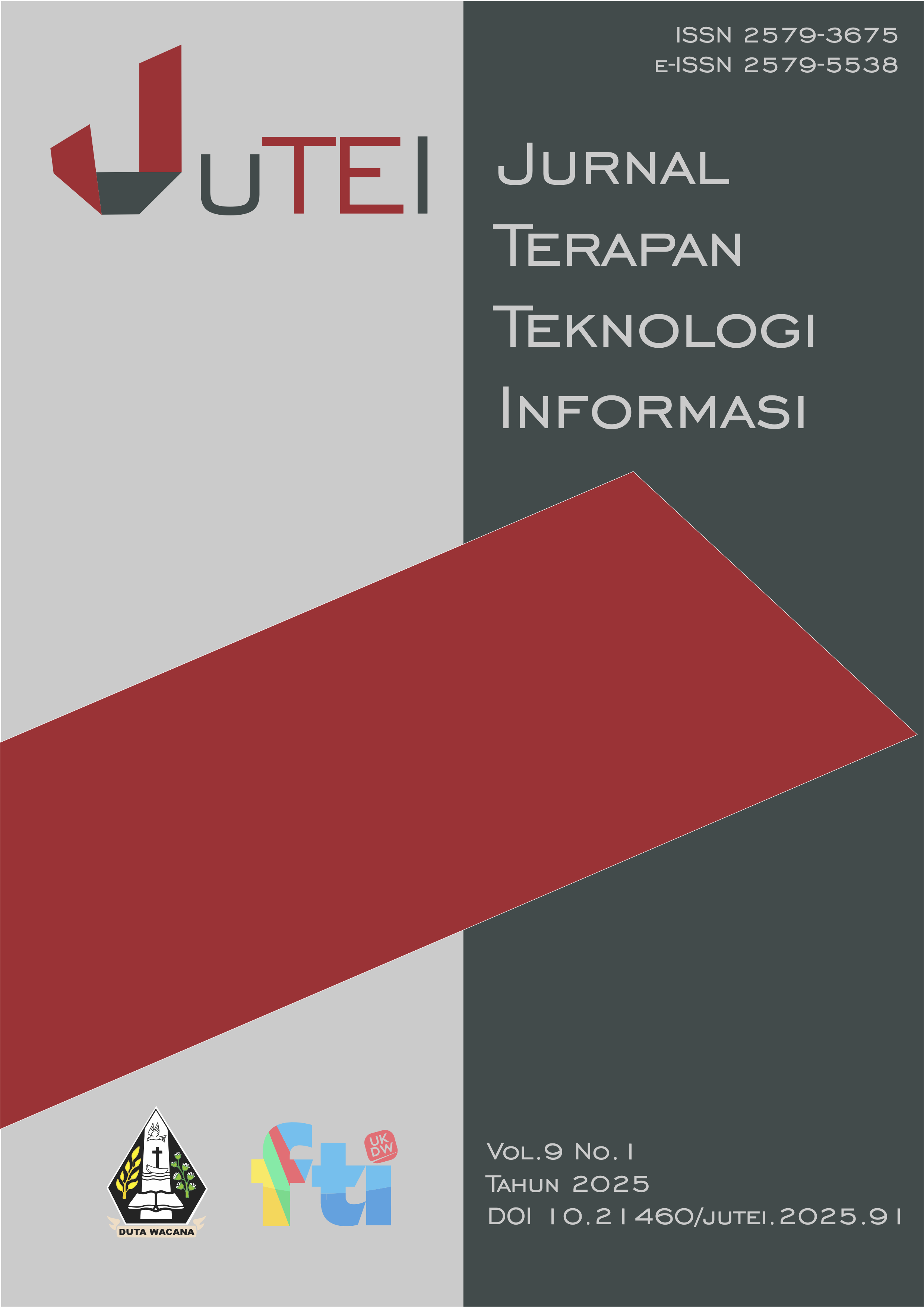Optimasi Akurasi Koefisien Pajak Kendaraan Bermotor di Indonesia Menggunakan Metode Klasifikasi dan Regresi
DOI:
https://doi.org/10.21460/jutei.2025.91.389Keywords:
AutoML, vehicle emissions, GridSearchCV, machine learning, motor vehicle taxAbstract
The growing awareness of the impact of motor vehicle emissions on the environment has encouraged Indonesia’s Ministry of Environment and Forestry to enforce emission testing regulations. These emission standards serve as a basis for calculating Motor Vehicle Tax (PKB). The Transportation Technology Research Center (BRIN) developed a tax coefficient prediction system to support this policy. Initial research utilized Orange Data Mining for machine learning analysis with algorithms like Random Forest, Neural Network, and AdaBoost. However, Orange Data Mining has limitations in flexibility, particularly in parameter tuning and preprocessing data, as well as inefficiencies in handling large datasets. This study adopts a more flexible approach, employing AutoML LazyPredict for quick identification of optimal models and GridSearchCV for hyperparameter optimization. The methodology involves two approaches: classification and regression. Classification employs models such as Support Vector Machine (SVM), K-Nearest Neighbors (KNN), Decision Tree, Extra Tree, and LightGBM, while regression utilizes Support Vector Regressor (SVR) optimized with GridSearchCV. Both approaches enable a comprehensive comparison and analysis of model performance. The results indicate that SVM and Decision Tree excelled in classification, achieving an accuracy of 100%. In regression, the models demonstrated high 16 performance with R² values ranging from 0.95 to 1.00, indicating exceptional predictive accuracy. Evaluations were conducted using metrics such as MAE, MSE, and R² for regression, along with accuracy scores and classification reports for classification tasks. This research underscores the effectiveness of machine learning model optimization, with both analyzed algorithms showing outstanding performance for classification and regression tasks.
References
I. M. Tirta, A. Riski, and N. Sholikhah, “Prediksi Harga Saham PT Bank Rakyat Indonesia Tbk Menggunakan AUTOML H2O Pendahuluan,” vol. 23, no. September, pp. 397–404, 2024.
G. Geadalfa and S. Saidah, “Auto Machine Learning dengan Menggunakan H2O Pendahuluan Tinjauan Pustaka Metode Penelitian,” J. Ilm. KOMPUTASI, vol. 20, no. 2, pp. 189–198, 2021.
W. Nugraha and A. Sasongko, “Hyperparameter Tuning pada Algoritma Klasifikasi dengan Grid Search Hyperparameter Tuning on Classification Algorithm with Grid Search,” Sist. J. Sist. Inf., vol. 11, no. 2, pp. 391–401, 2022, [Online]. Available: http://sistemasi.ftik.unisi.ac.id
N. Made, O. Wulaning, H. Elindra, and A. H. Saputra, “Prediksi Karbon Monoksida Menggunakan Model Machine Learning Berdasarkan Perbandingan Model Time Series Studi Kasus DKI Jakarta Carbon Monoxide Prediction Using Machine Learning Model Based on Time Series Model Comparison DKI Jakarta Case Study,” vol. 7, no. 3, pp. 1116–1128, 2024, doi: 10.56338/jks.v7i3.4819.
F. Hidiyanto, K. Fajar, A. Sukra, R. Fajar, N. S. Octaviani, and D. A. Sugeng, “Modeling Indonesian Motor Vehicle Tax Coefficients Based on Machine Learning Emission Data,” J. Ind. Res. Innov., vol. 17, no. 1, pp. 16–23, 2023, [Online]. Available: https://ejournal.brin.go.id/MIPI/article/view/1734
S. R. Pandala, “Welcome to Lazy Predict’s documentation! — Lazy Predict 0.2.12 documentation,” 2022. https://lazypredict.readthedocs.io/en/latest/ (accessed Nov. 25, 2024).
Vapnik and V. N., “The Nature of Statistical Learning,” Theory. p. 334, 1995.
T. M. Cover and P. E. Hart, “Nearest Neighbor Pattern Classification,” IEEE Trans. Inf. Theory, vol. 13, no. 1, pp. 21–27, 1967, doi: 10.1109/TIT.1967.1053964.
M. M. Muttaqin, Wahyu Wijaya Widiyanto, A. W. Green Ferry Mandias, Stenly Richard Pungus, S. A. H. Wiranti Kusuma Hapsari, E. F. B. Aslam Fatkhudin, Pasnur, and N. S. Mochammad Anshori, Suryani, Pengenalan Data Mining, no. July. 2023.
P. Geurts, D. Ernst, and L. Wehenkel, “Extremely randomized trees,” Mach. Learn., vol. 63, no. 1, pp. 3–42, 2006, doi: 10.1007/s10994-006-6226-1.
M. A. Muslim, Y. Dasril, M. Sam’an, and Y. N. Ifriza, “An improved light gradient boosting machine algorithm based on swarm algorithms for predicting loan default of peer-to-peer lending,” Indones. J. Electr. Eng. Comput. Sci., vol. 28, no. 2, pp. 1002–1011, 2022, doi: 10.11591/ijeecs.v28.i2.pp1002-1011.
A. J. Smola and B. Sch, “Smola, Schölkopf - 2004 - Statistics and Computing - A tutorial on support vector regression.pdf,” Stat. Comput., vol. 14, no. 3, pp. 199–222, 2004.
G. Louppe, “Understanding Random Forests: From Theory to Practice,” no. July, 2014, [Online]. Available: http://arxiv.org/abs/1407.7502
G. Biau and E. Scornet, “A random forest guided tour,” Test, vol. 25, no. 2, pp. 197–227, 2016, doi: 10.1007/s11749-016-0481-7.
O. Chung, Second edition, vol. 69, no. 4. 2019.
A. R. Chrismanto, A. K. Sari, and Y. Suyanto, “Enhancing Spam Comment Detection on Social Media With Emoji Feature and Post-Comment Pairs Approach Using Ensemble Methods of Machine Learning,” IEEE Access, vol. 11, no. June, pp. 80246–80265, 2023, doi: 10.1109/ACCESS.2023.3299853.
Downloads
Published
How to Cite
Issue
Section
License
Copyright (c) 2025 Joiner Tennye Ariel Togatorop, Antonius Rachmat Chrismanto, Willy Sudiarto Raharjo

This work is licensed under a Creative Commons Attribution-NonCommercial-NoDerivatives 4.0 International License.
Authors who publish articles in JUTEI agree on the following rules:
1. The author grants non exclusive royalty free rights, and is willing to publish articles online and complete (full access). With such rights JUTEI reserves the right to save, transfers, manages in various forms, maintains and publishes articles while keeping the author's name as the copyright owner.
2. Each author contained in the article has contributed fully to the substance and intellectual, and is accountable to the public. If in the future there is a copyright infringement notification then this will be responsibility of the author, not JUTEI.







